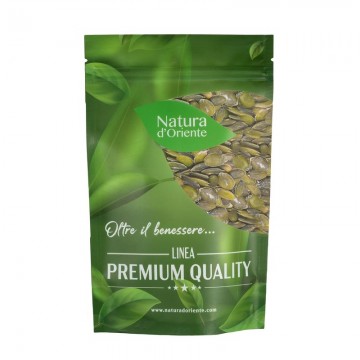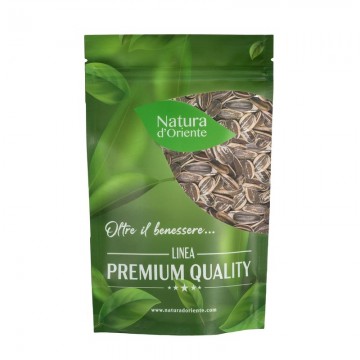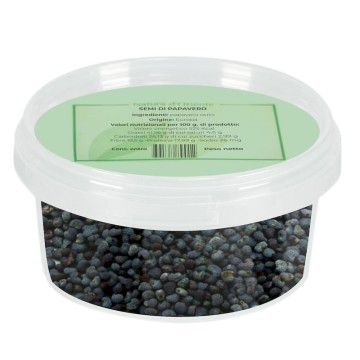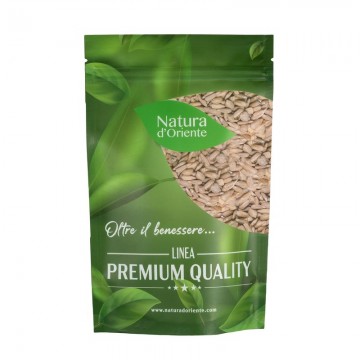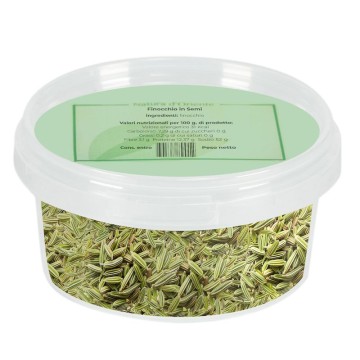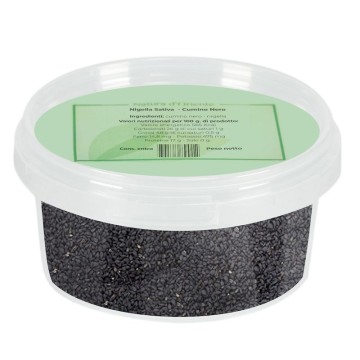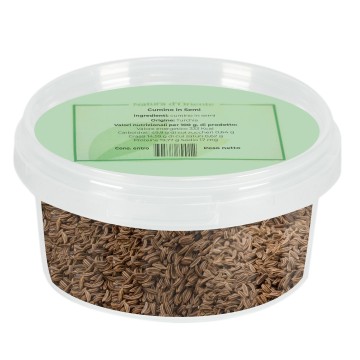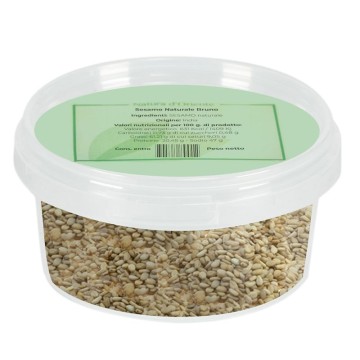These oil seeds represent an unhulled, natural and untoasted version. They are sesame seeds without the outer skin, ready to be used in the kitchen either raw or cooked or toasted in a pan. They are often used in an eclectic way, from decorations in bread making to garlic sautés, in salad dressings and other first and second courses. The natural hulled sesame shows slight differences in the delicate less bitter flavor, and in the softer consistency, compared to the version of the seed with the intact shell. Toasting intensifies its nutty aromas, perfect both in sweet preparations and in savoury dishes. These seeds are widespread in all world cuisines, particularly in Asian and Middle Eastern ones, appreciated for their taste and for their richness in nutrients - excellent for including healthy vegetable fats in the diet. They are perfect for flavoring creative recipes, as healthy snacks, to flavor salads and vegetable dishes.
What are the properties of sesame seeds?
These hulled seeds show different nutritional characteristics, being rich in beneficial compounds. They make antioxidant polyphenols, mineral salts, vitamins, fatty acids and proteins available to our body. Their nutritional richness is considered advantageous for a supportive and restorative diet, useful for maintaining well-being and improving it through a diversified diet. The antioxidants contained in the seeds, such as vitamins, polyphenols, lignans and folic acid, promote an action of contrasting free radicals – molecules that can cause damage to cells. An action also enhanced by the B vitamins and vitamin E, contained in sesame seeds together. In addition, these hulled oil seeds contain other essential minerals for the body such as calcium, magnesium, phosphorus, iron, manganese, selenium, zinc. These are precious compounds, especially in the case of calcium, abundant in the seeds and useful for the well-being of bones and teeth.
These nutrients are important for the functioning of the metabolism, cells and the immune system. Other beneficial components of sesame seeds are proteins and "good" unsaturated fatty acids, such as oleic acid, linoleic acid, palmitic and stearic acid - precursors of omega 3 acids. Healthy fats that help reduce cardiovascular risk by controlling LDL cholesterol levels in the blood. As natural supplements of many elements, these seeds contribute to supporting the body, counteracting physical and mental fatigue. To increase well-being, the consumption of natural hulled sesame contributes to proper digestion. Fibers combat constipation and help develop healthy intestinal bacterial flora. Hulled sesame seeds have an advantage for digestion, since they are free of the outer shell that is not always easy to assimilate; furthermore, they help to better absorb nutrients, which in the whole version are enclosed in the shell and risk not being completely absorbed. It is no coincidence that sesame seeds are one of the favorite foods in the macrobiotic diet. They are also a tasty and calcium-rich alternative for those who cannot consume dairy products and milk derivatives.
Contraindications of hulled sesame seeds
These oil seeds are safe for consumption, but it is necessary to moderate their intake to avoid some unwanted effects. Excessive consumption of sesame seeds could cause digestive problems, with the appearance of stomach pain, abdominal swelling and excess gas. They are not recommended for those with allergies or difficulty digesting nuts and seeds.
Where can you buy hulled sesame seeds?
These hulled seeds are a natural version of some available varieties, produced with toasted seeds and additional elements such as oil, salt and sugar. Those looking for untreated sesame without the outer shell can easily find it in specialized spice shops such as Natura d'Oriente. In our e-shop you can buy natural hulled sesame online, selected for its high quality and nutritional value. Our packs contain loose sesame seeds, available in a choice of weights between 75 g, 100 g, 150 g, 250 g, 500 g and 1 kg, always at a convenient price. We put the spices in airtight freshness-saving packages, for correct and long-lasting preservation.
How to use hulled sesame seeds in the kitchen?
QueThese seeds are not toasted and without the outer shell, and are ready to be added to both baked goods and some recipes to garnish or flavor. They give a delicate, almost neutral flavor but with a light nutty note, which intensifies with toasting. The shelled seeds can be added to recipes directly, for toasting and cooking, or ground at the moment, depending on the needs of the recipe. Like many oilseeds, they can be sprinkled as garnishes in salads, on cold dishes or in sauces, on dishes at the end of cooking. They are often incorporated into baked goods, giving a delicious and beneficial touch to doughs. This type of cooking is typical of Asian and Middle Eastern cuisines, where traditionally sesame seeds are incorporated into hot dishes through toasting. How do you toast sesame seeds? They are usually added to a dry pan, perhaps together with other seeds and spices, to release the aroma and give depth to the flavor. These seeds should be toasted quickly, about 1-2 minutes, to intensify the nutty notes and add complexity to recipes. Be careful not to overcook them to avoid the formation of harmful substances and flavor, losing nutritional values and acquiring an unpleasant taste. After toasting, sesame seeds are added to sautéed oil and garlic, with butter or other ingredients in various hot dishes. Alternatively, the seeds can be ground, crushing them with a spice grinder or with a mortar and pestle. Grinding should be done immediately, just before adding them to the recipe, to maintain the aromatic profile and nutritional values (fats tend to go rancid in the air).
Dehulled sesame in recipes
Baked goods: the seeds enhance the flavor of bread, rolls, focaccia, crackers, bagels, and leavened dough. They give a fragrant aroma and a crunchy texture to many baked goods, as a garnish sprinkled on the surface - in this sense they are widely used in Europe and North America. Savoury recipes: they can be toasted to enrich first and second courses, following the tradition of Middle Eastern and Asian cuisines (Chinese, Japanese and Korean). They release a pleasant aroma and a nutty taste appreciated in sautés, soups and cream soups, broths, vegetables (sautéed, boiled or grilled). They flavour fried tofu and Asian dishes of noodles, ramen and rice. They are used raw or toasted, to be scattered on salads and cold dishes. Meat and fish: sesame seeds infuse crunchiness and substance to fish and chicken breading, in the preparation of meatballs and hamburgers. They are used raw sprinkled on meat and fish dishes after cooking, in sushi or salmon rolls with sesame. Sweet recipes: they give desserts delicate notes, reminiscent of hazelnut, appreciated in the dough of cakes, biscuits, creams and puddings. They can be ground or not, to make aromatic yogurt, smoothies, centrifuges, kefir, vegetable milk and fruit salads. They are an energetic addition to granola, breakfast cereals, energy bars. They are used in Middle Eastern pastry recipes, including the Arabic sweet halva, based on crushed and sugared sesame seeds. Sauces: these hulled seeds are used for the preparation of tahini and hummus, typical of Middle Eastern cuisine. Toasted and then ground, they create a base for creamy and tasty dressing sauces. They can be transformed by including honey or sesame oil, for a sweet-salty aroma. The seeds can flavor butter, oil and combine with other spice and oilseed mixtures. They are one of the ingredients of gomasio, a typical Japanese condiment.
The Recipe: Sesame Seared Beef with Peppers and Zucchini
Ingredients: 150g beef rump, cut into strips - 3 tablespoons soy sauce - 1 tablespoon sesame seeds - 1 tablespoon sesame oil - ½ teaspoon dried chili flakes - 2 tablespoons olive oil - ½ red pepper, sliced -1 courgette, thinly sliced - 150g noodles - 3 tablespoons chopped coriander leaves - 2 lime slices Preparation Mix the meat with the soy sauce, sesame seeds, sesame oil and chili flakes in a bowl. Marinate for ten minutes. Heat a griddle until hot, add the meat and grill for 2-3 minutes. Prepare the noodles as a side dish, cooking them according to the directions. Meanwhile, heat the olive oil in a pan, add the bell pepper and courgette and fry for 2-3 minutes. Add the cooked and drained noodles and mix. Add the cilantro and stir. To serve, placePlace the noodles on a serving plate, add the beef and garnish with lime slices.
Where do sesame seeds come from
They come from the plant Sesamum indicum, which belongs to the Pedaliaceae family. It is a plant native to the tropical belt of Asia or East Africa, and the name indicum highlights its origin from India (by extension from the East). The small, oily and flat sesame seeds grow in pods and can be of different colors (white, red, gold, brown, black, etc.) - of which the white variety is very common. It is a plant known for millennia and is still cultivated in many corners of the world, appreciated for its nutritional properties.
The ancient Egyptians ground sesame seeds as flour, and also introduced them for nutritional and healing purposes. In the Ebers Papyrus (ca. 1550 BC), with the term semsent, sesame was considered a natural remedy against headaches and hemorrhages. In China and India, the seeds were used ground as a tasty seasoning for food. They were considered beneficial for their natural healing properties and, in addition, used for ritual and cosmetic purposes - in addition to obtaining a fuel oil for lamps. Due to its versatility, sesame was considered a celestial gift, and in Indian literature its origin is in the gift granted to humans by the deity Vishnu: sesame seeds were born from the drops of his sweat. The importance of sesame is reported in Indian Ayurvedic Medicine, where the seeds are stimulants for digestion and help natural cures of the genitourinary system. In the sacred Buddhist texts, sesame is considered a superior food, consumed by monks. Buddha cited how "the sesame seed, despite being very small, could generate a large tree". In the oriental tradition of the "One Thousand and One Nights" stories, we remember the magical powers of the formula "Open Sesame", with which Ali Baba tried to open the rock of a cave full of hidden treasures.
The phrase recalls the opening of the sesame fruit, which contains seeds rich in restorative properties - a "treasure" of strength and vitality. In our country, sesame seeds arrived on the table in Roman times, they began to spread, especially in Sicily where they were sprinkled on bread. The Romans ground sesame seeds with Roman cumin, to obtain an intense spicy condiment. Today they are very popular in Africa and Mediterranean countries, enjoyed together with raw honey in sesame cakes and with sesame oil to create tahini sauce.








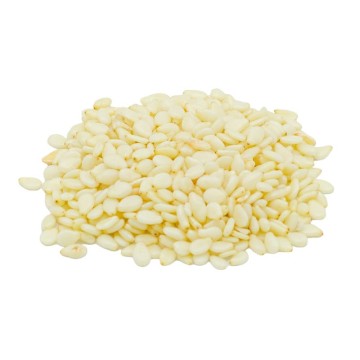
 No reward points for this product.
No reward points for this product.


